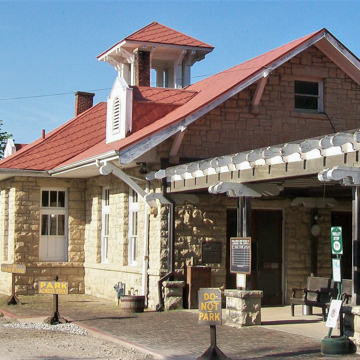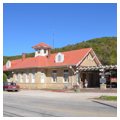Built in the then new and fashionable Craftsman mode, the station employs the locally favored rusticated limestone masonry. The rectangular building has a red tile roof with deep eaves supported on large brackets, two dormer windows on each of its long sides, and a cupola with a pyramid roof. The flat-roofed shelter over the south end of the passenger platform is a flamboyant collection of Craftsman details: shaped wooden capitals topping the wooden columns that stand on stone bases and cantilevered roof joints shaped to match the column capitals. Although automobile traffic rendered the passenger railroad obsolete and the line ceased operation in the early 1920s, short recreational scenic runs and dining cars have become a popular attraction. This was the second railroad station on this site; it replaced a depot of 1912.
You are here
Eureka Springs Missouri and North Arkansas Railroad Depot
If SAH Archipedia has been useful to you, please consider supporting it.
SAH Archipedia tells the story of the United States through its buildings, landscapes, and cities. This freely available resource empowers the public with authoritative knowledge that deepens their understanding and appreciation of the built environment. But the Society of Architectural Historians, which created SAH Archipedia with University of Virginia Press, needs your support to maintain the high-caliber research, writing, photography, cartography, editing, design, and programming that make SAH Archipedia a trusted online resource available to all who value the history of place, heritage tourism, and learning.





